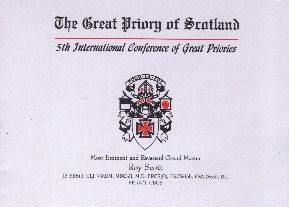

The Origins of Freemasonry
A Lecture given on 25 August 2000, at the
5th International Conference of Great Priories
in
The Albert Halls, Stirling, Scotland
by
Dr Robert Lomas
of
University of Bradford
and
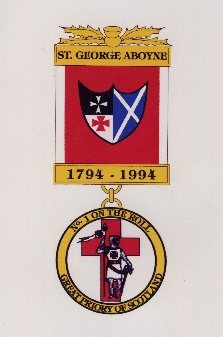
Freemasonry, in the form we would recognise today, started at the building of Rosslyn Chapel near Edinburgh.
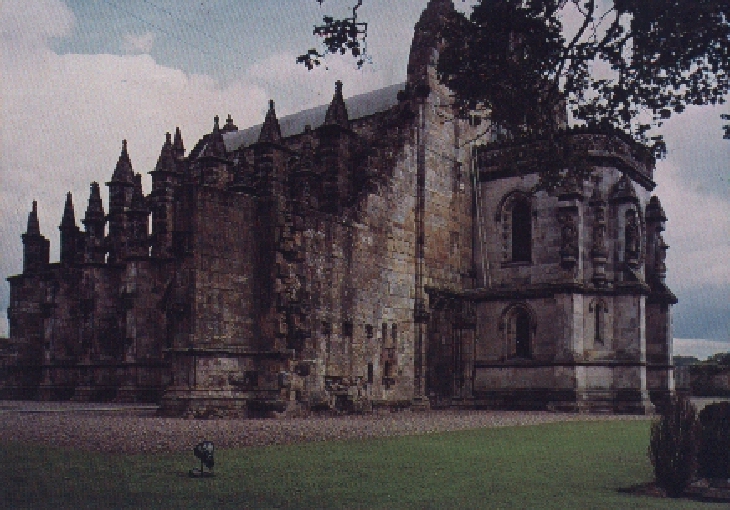
Rosslyn Chapel, before the present external roof was put in place
There are three important pieces of evidence which support this statement.
Rosslyn links the Jewish Temple through the Knights Templar to Freemasonry.
The ground plan of Rosslyn is a copy of Herod’s Temple and above ground it replicates the Herodian Architecture of Jerusalem.
Rosslyn contains the oldest document showing a modern First Degree Ceremony being conducted by a Knight Templar.
The layout of Rosslyn, which was started in 1440, is an exact replica of the ground plan of the Third Temple, built in Jerusalem by Herod and destroyed in the First Century by the Romans.
(See The Hiram Key, Christopher Knight and Robert Lomas, Arrow, London, 1997 for full details)
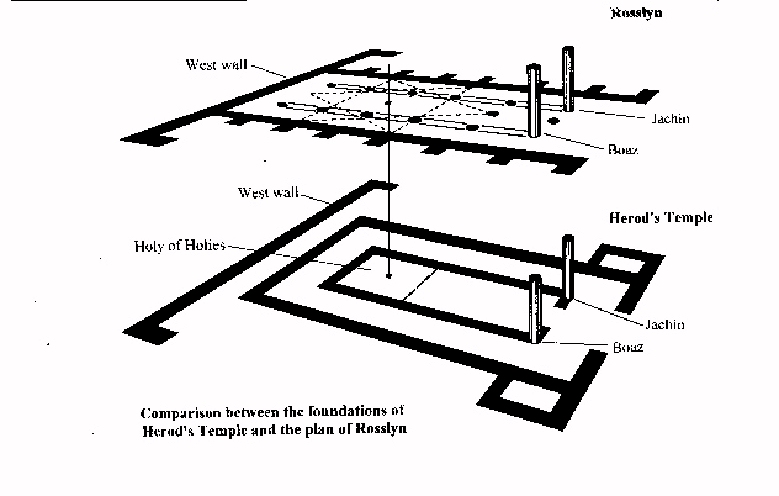
The layout of Herod's Temple was not known to Archeologists until the mid nineteenth century, nearly four hundred years after the construction of Rosslyn
All the carvings in Rosslyn were first cut in wood and produced to the Master of Works for inspection before being cut in stone. This is one of the earliest examples of Quality Control in Britain.
On the lower frame of the window in the South West corner of the Chapel there is a carving which seems to be of a Freemasonic First Degree.
(See The Second Messiah, Christopher Knight and Robert Lomas, Arrow, London, 1998 for full details)
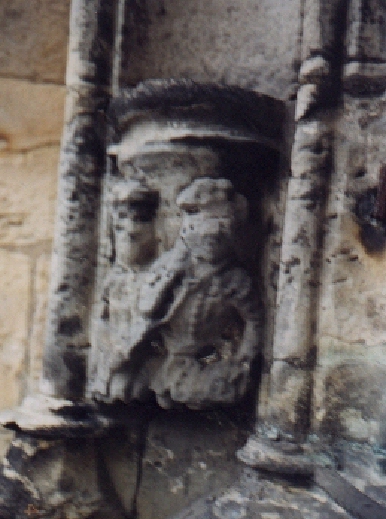
This carving shows seven distinct points of similarity to the modern First Degree of Freemasonry, and it was carved between 1440-50. It was inspected and passed before being cut in stone so the features within it are intended to be there.
John Hamill, the Librarian of the United Grand Lodge of England, has suggested that it may be just co-incidence that this little figure seems to show a link between Templarism and Freemasonry.
The figure shows a man kneeling between two pillars. He is blindfolded and has a running noose about his neck. His feet are in a strange and unnatural posture and in his left hand he holds a bible. The end of the rope about his neck is held by another man who is wearing the mantle of a Knight Templar.
Now for those of you are not familiar with our strange ways of within the craft, when somebody is admitted they are called the Candidate. Men are admitted to men's lodges and women to separate women's lodges. The candidate is dressed in a very odd manner but will only be admitted when properly dressed for the ceremony. The way of dressing is to wear a rough white clothing folded back to reveal particular parts of the body. The candidate is blindfolded and has a running noose about his neck. Here is a picture of a Masonic candidate who is correctly dressed for the ceremony standing before the two pillars that appear in every Masonic Lodge.
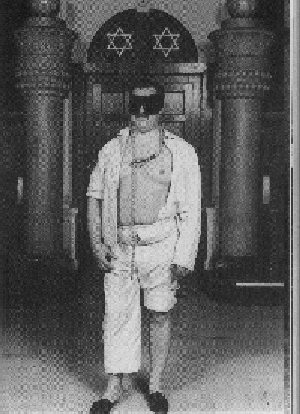
A Candidate properly prepared to be made a Mason
The statue at Rosslyn shows a number of features which are now considered to be Masonic. Here is a drawing of the main features of the Statue.
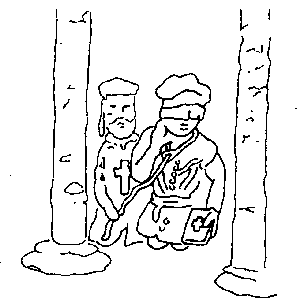
Drawing of the main features of the carving
The problem for John Hamill is that the statue was carved five hundred and fifty years ago and this is two hundred and seventy years before the claimed founding of the Craft in England. When Chris Knight and I published this information it caused a tremendous fuss in English Freemasonry. Many articles were written by various Masonic writers supporting the Hamill's view that these similarities were simply co-incidence.
How, the gentleman from England must have asked themselves, could Freemasonry have come from such an outlandish place as Scotland? :-)
(This lecture was delivered in Stirling surrounded by many Scots, as well as a considerable number of overseas delegates. This statement caused considerable amusement)
However, their counter claim of co-incidence, can be tested using standard techniques of Hypothesis Testing and here is the detailed calculation.
There are seven points of congruence (agreement) between the carving and the modern Masonic ceremony. These are
1. The man is blindfolded. This is unusual in medieval statues and the only other example it the figure of blind justice. There is no other blindfold figure carved in Rosslyn.
2. The man is kneeling. This is fairly common in medieval carvings and there are other kneeling figures in Rosslyn.
3. The man is holding a bible in his left hand. There are a number of other carvings showing figures holding books or scrolls within Rosslyn.
4. The man has a noose about his neck. There are few known figures of the period showing nooses about their necks. The best known is the statue called 'The dying Gaul'. There is one other figure in Rosslyn which has a noose in it and that is the figure of the hanged man which represents the angel Shemhazai whose sins caused God to send the Flood and who was so afraid to face God that he hung himself between heaven and earth with his face away from God. Shemhazai is carved with a noose about his feet but there is no other noose carved in Rosslyn.
5. The man has his feet in the posture that is still used today by Masonic candidates. This is a very unusual position and does not occur in any other carvings in Rosslyn.
6. The ceremony is being carried out between two pillars as it is in a Masonic Lodge. Pillars figure in a lot of the carvings at Rosslyn.
7. The noose is being held by a man clearly dressed as a Templar. There are many Templar symbols and images of Templars carved in Rosslyn.
So what is the chance of all these factors coming together by chance? I set up a null hypothesis that it was pure co-incidence that all these elements linking Templarism and Freemasonry occurred in the same carving and then set out to test the probability of the idea.
1. The probability that the figure is blindfolded by chance is 0.5 as it can only be blindfolded or not blindfolded. This is a worst case probability that gives the null hypothesis the best chance of succeeding as there is no other blindfolded figure in Rosslyn.
2. The probability that the figure is kneeling by chance is 0.5 as it again can only be kneeling or not kneeling.
3. The probability that the figure is holding a bible by chance is 0.5 as there are again only two possibilities. Holding a bible or not holding a bible.
4. The probability that the figure has noose about its neck by chance is 0.5 even though it is the only figure in Rosslyn with a noose about its neck. Again I am giving the Null Hypothesis the best possible chance of succeeding.
5. The probability that the figure has his feet in a Masonic posture (which the ritual says is the only way a Candidate will be admitted to Freemasonry) by chance is 0.5 because he can have them that way or not. No other figure in Rosslyn holds in feet in this strange symbolic way so again the Null Hypothesis is being given the full benefit of any doubt.
6. The probability that the ceremony is taking place between two pillars by chance is 0.5 because the alternative would be not to place the two pillars there.
7. The probability that a Templar is holding the noose by chance is 0.5 and this is generous towards the Null Hypothesis because the rope could be loose or held by somebody who is not a Templar. In the modern Masonic ceremony the rope is held by the senior deacon whilst the candidate takes his oath hold the bible.
I now needed to consider the possibility of all these seven probabilities occurring at the same time. To find the composite probability I must multiply the separate probabilities together.
So the highest possible probability of the null hypothesis being true is
(0.5)*(0.5)*(0.5)*(0.5)*(0.5)*(0.5)*(0.5) which works out as 0.0078
So there are only eight chances in a thousand that all these elements linking Freemasonry to Templarism and Sir William St Clair are there by co-incidence. This probability is less than the 95% confidence level one in 20 and less than the 99% confidence level of one in 100. There is only one chance in 128 of the links being co-incidence. On this evidence I reject the null hypothesis, that leaves me with a strong claim that Sir William was linked to Freemasonry in 1440 and that this link involved Templars.
So to sum up, if each point of similarity is given a 50% chance of being there by accident. (Which is giving the opposite view the best odds possible) There are only 8 chances in 1000 that it is pure chance.
Rosslyn was built by Sir William St Clair Last St Clair Jarl of Orkney. He was a direct descent of William de St Clair Last Temple Grand Master of Scotland, who died taking the heart of the dead king, Robert de Bruce on a last crusade to Jerusalem.
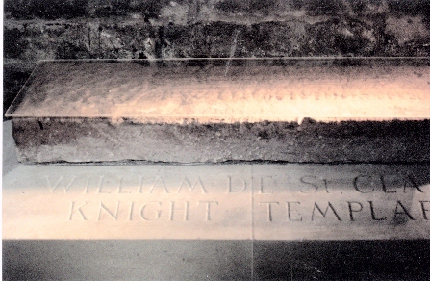
The Tombstone of the Templar Sir William St Clair, preserved in Rosslyn
Sir William, the chapel builder, is also the direct ancestor of First Grand Master Mason of Scotland, also named William St Clair (Sinclair)
To house artifacts brought by the Knights Templar to Scotland in 1126. Between 1118 and 1128 the Templars excavated the ruins of Herod’s Temple in Jerusalem. Hugue de Payen, first Grand Master of the Knights Templar, served on the First Crusade with Henri St Clair, First Earl of Roslin and Hugue visited Roslin in 1126 where he was given land to build the first Templar Preceptory outside the Holy Land.
In 1860 the British Army Engineers mounted an expedition to Jersualem and two Lieutenants ,Wilson and Warren, mapped out the city to Ordnance Survey standards. They excavated beneath Temple Mount and found many deep tunnels in which they also found and recorded Templar artifacts.
(See The Second Messiah, Christopher Knight and Robert Lomas, Arrow, London, 1998 for full details)
Here is an illustration of the shaft and tunnels dug by the Templars beneath Temple Mount, taken from the Army report of 1870

Drawing of the tunnels found by the British Army Expedition which excavated below Temple Mount in Jerusalem showing the tunnels left by Templars The shaft is 80 feet deep.
In 1440 William St Clair was the most powerful man in Scotland.
He decided to build Rosslyn to house the treasures he had inherited from the Templars and establish a seat of spiritual authority to rival James II who was dabbling in English politics and finally got himself killed during the War of the Roses.
William brought in Masons to build Rosslyn and built the town of Roslin to house them.
When James II died (1460) his son, James III, thought William was posing to great a threat to the Crown of Scotland so he stripped William of Orkney and broke up his estates
So now we have visited briefly some of the key events involved in the creation of Freemasonry. There is much more to the story, for example the St Clairs had lands at Kilwinning and were involved with famous Mother Kilwinning Lodge there, but there is not enough time today to tell the full story. So let me finish with a Timeline of the Key events which led to the Formation of the Grand Lodge of Scotland in 1736.
1440 Masons given the Mason word by William to preserve the secrets of the Templars he was building Rosslyn to house.
1483 The burgh of Aberdeen is recorded as being involved in settlement of a dispute between six ‘masownys of the lurge’. Masonry is starting to spread out as lodges initiate Candidates and give the the 'Mason Word'
1599 Earliest surviving Lodge Minutes from Edinburgh
1601 James VI made a Mason at Lodge of Scoon and Perth.
1602 William Schaw sets up the modern lodge system in Scotland following the instructions of James VI
1602 The Lodges of Scotland affirm William St Clair of Roslin as hereditary Grand Master Mason of Scotland from TI
1603 James VI takes Freemasonry to England when he becomes James I of Britain
1641 Sir Robert Moray becomes the first Mason recorded to be made on English Soil.
1715 First Jacobite Rising, lodges begin to disclaim their Scottish roots
1717 Formation of Grand Lodge of London denies Jacobite Heritage
1725 First National Grand Lodge formed in Ireland
1736 Grand Lodge of Scotland Formed as a counter measure to London expansionism.
1736 William St Clair of Roslin made First Grand Master Mason of Scotland and signs away his hereditary rights in favour of elected officers.
Let me leave you with a portrait of William Sinclair of Roslin, First Grand Master Mason of Scotland 1736

Incidentally, William had to be made a Mason before he could take over as grand master mason.